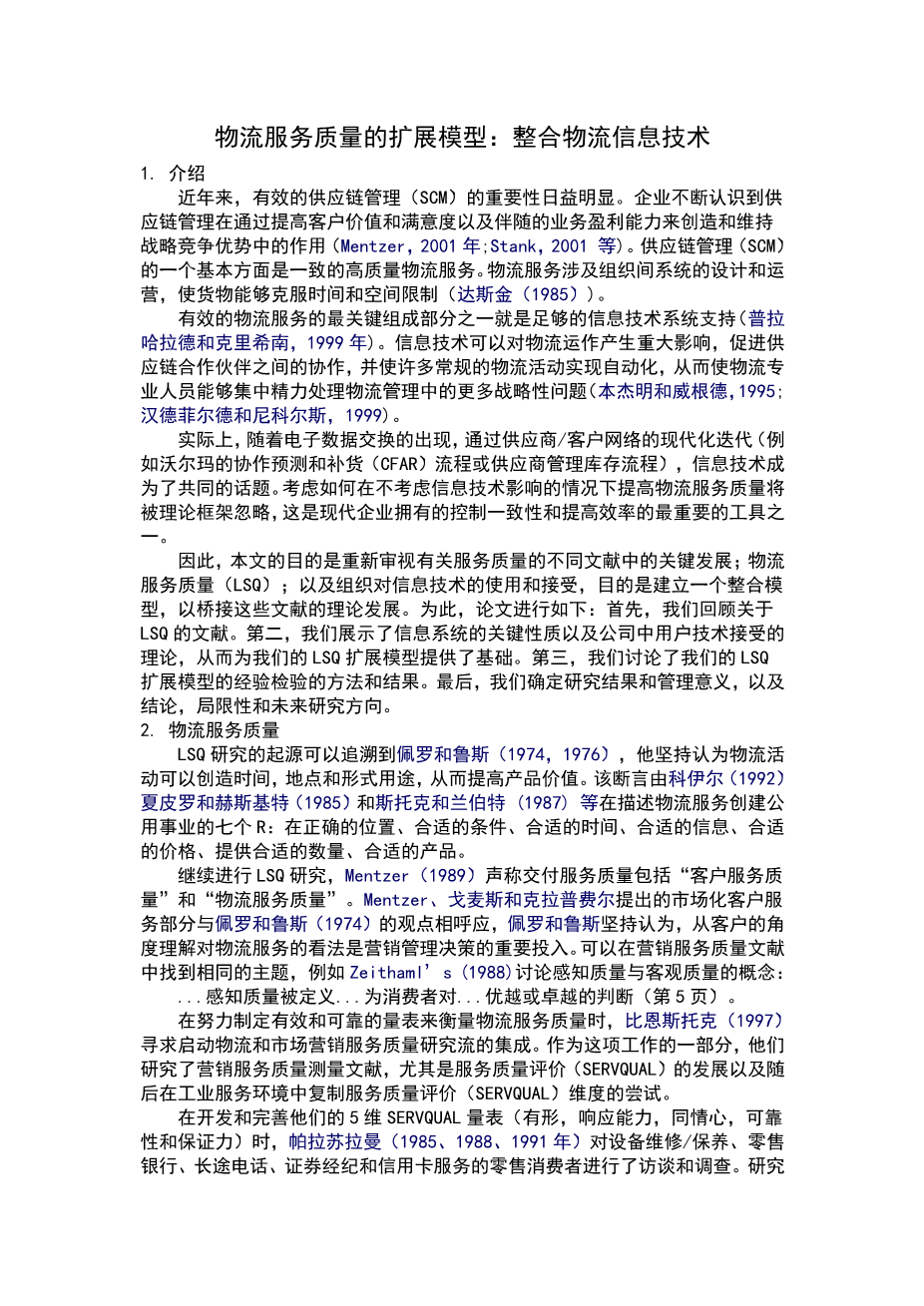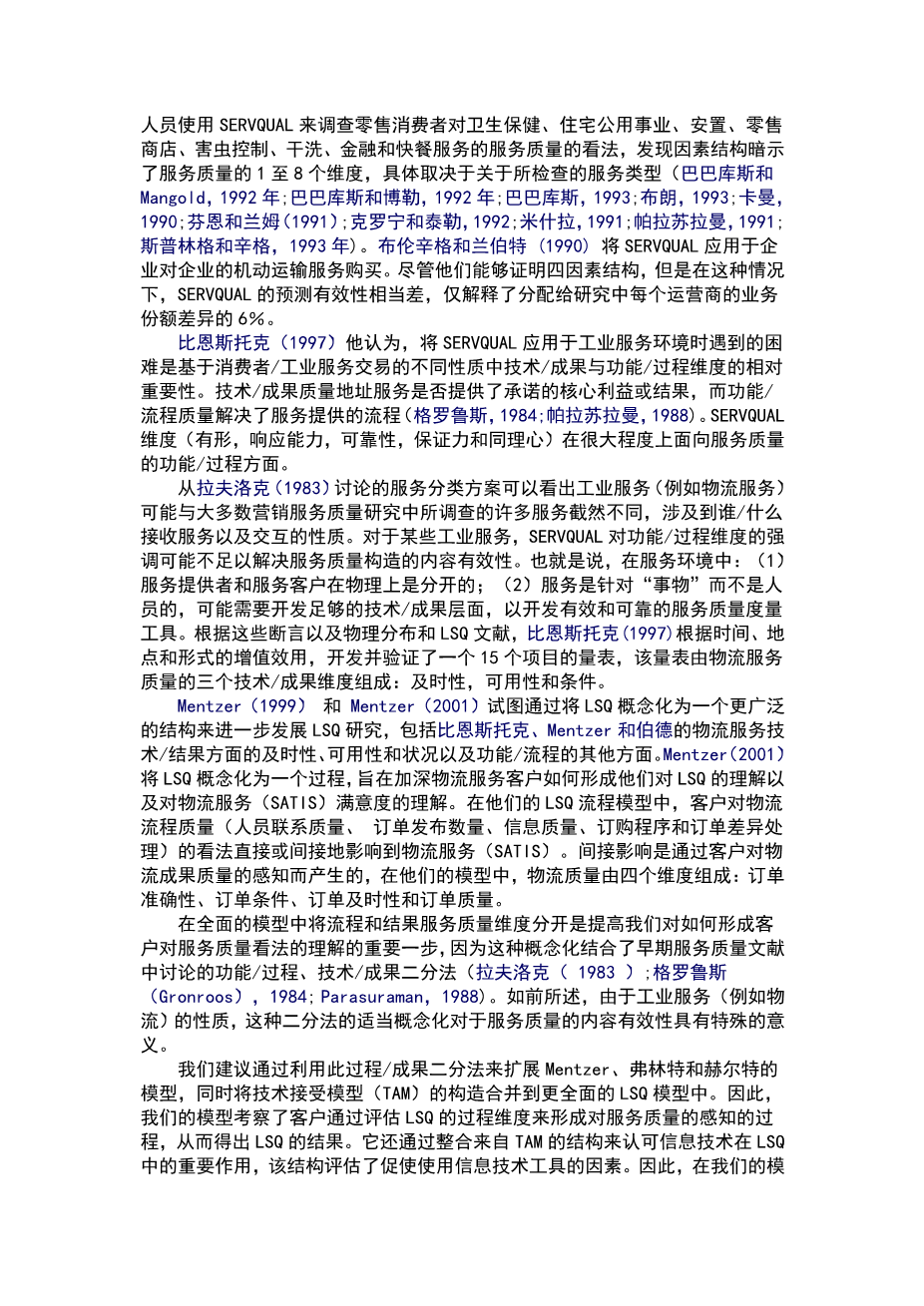An expanded model of logistics service quality: Incorporating logistics information technology
1. Introduction
The importance of effective supply chain management (SCM) has become increasingly apparent in recent years. Businesses continue to recognize the role of SCM in creating and maintaining a strategic competitive advantage through increased customer value and satisfaction and the attendant business profitability (Mentzer, 2001; Stank et al., 2001). An essential aspect of SCM is consistent, high-quality logistics services. Logistics services involve the design and operation of inter-organizational systems that allow goods to overcome time and space
constraints (Daskin, 1985).
One of the most critical components of effective logistics services is adequate information technology systems support (Prahalad and Krishnan, 1999).Information technology can have significant effects on logistics operations, facilitating collaboration among supply chain partners, as well as allowing the automation of many routine logistics activities, thus
enabling logistics professionals to focus on more strategic issues in logistics management (Benjamin and Wigand, 1995; Handfield and Nichols, 1999).
Indeed, from the advent of Electronic Data Interchange, through more modern iterations of supplier/customer networking such as Wal-Martrsquo;s Collaborative Forecasting and Replenishment (CFAR) process or vendor-managed inventory processes, information technology is the common thread. To consider how to improve the quality of logistics services without considering the impact of information technology would be to omit from the theoretical framework one of the most important tools for controlling consistency and improving efficiency that modern business has at its disposal.
For this reason, the goal of this paper is to revisit key developments in the distinct bodies of literature on service quality; logistics service quality (LSQ); and organizational use and acceptance of information technology, with the objective of developing an integrative model that bridges the theoretical developments in these literature. To that end, the paper proceeds as follows: first we review literature on LSQ. Second, we demonstrate the critical nature of information systems and theories of user technology acceptance in the firm to provide the basis for our expanded model of LSQ. Third, we discuss the methodology and results of an empirical test of our expanded model of LSQ. Finally, we identify
research and managerial implications of our findings, along with conclusions, limitations, and directions for future research.
- Logistics service quality
The origins of LSQ research can be traced back to Perreault and Russ (1974, 1976), who maintained that logistics activities create time, place, and form utility, thereby enhancing product value. This assertion was extended by Coyle et al. (1992) Shapiro and Heskett (1985) and Stock and Lambert(1987) in describing the seven Rs of utility creation by logistics services: delivering the right amount, the right product, at the right place, in the right condition, at the right time, with the right information, and at the right price.
Continuing the development of LSQ research, Mentzer et al. (1989) asserted that delivery service quality consisted of “customer service quality”and“physical distribution service quality.” The marketing customer service component proposed by Mentzer, Gomes and Krapfel echoes a contention by Perreault and Russ (1974), who maintained that understanding perceptions of physical distribution service from a customerrsquo;s point of view was an essential input in marketing management decisions.This same theme can be found in the marketing service quality literature, e.g., Zeithamlrsquo;s (1988) discussion of the concept of perceived versus objective quality:
perceived quality is defined y as the consumerrsquo;s judgment about y superiority or excellence (p. 5).
In their efforts to develop a valid and reliable scale for measuring physical distribution service quality, Bienstock et al. (1997) sought to initiate an integration of the logistics and marketing service quality research streams. As part of this endeavor,they examined the marketing service quality measurement literature, particularly the development of SERVQUAL and subsequent attempts at replication of SERVQUALrsquo;s dimensions in industrial service contexts.
In developing and refining their five-dimensional SERVQUAL scale (tangibles, responsiveness,empathy, reliability, and assurance), Parasuraman et al. (1985, 1988, 1991) interviewed and surveyed retail consumers of appliance repair/maintenance,retail banking, long-distance telephone, securities brokerage, and credit card services. Researchers
using SERVQUAL to investigate service quality perceptions of retail consumers of health care,residential utility, placement, retail store, pest control, dry cleaning, financial, and fast food services have found factor structures suggesting from one to eight dimensions of service quality,depending on the type of service examined (Babakus and Mangold, 1992; Babakus and Boller, 1992;Babakus et al., 1993; Brown et al., 1993; Carman,1990; Finn and Lamb, 1991; Cronin and Taylor,1992; Mishra et al., 1991; Parasuraman et al., 1991;Spreng and Singh, 1993). Brensinger and Lambert(1990) applied SERVQUAL to business-to-business purchases of motor carrier transportation services.Although they were able to demonstrate a fourfactor structure, the predictive validity of SERVQUAL in this context was quite poor, explaining only 6% of the variance in share of business apportioned to each carrier in the study.
Bienstock et al. (1997) maintained that the difficulties encountered in applying SERVQUAL to an industrial service context were based on the
relative importance technical/outcome versus functional/process dimensions play in the divergent nature
剩余内容已隐藏,支付完成后下载完整资料


英语译文共 5 页,剩余内容已隐藏,支付完成后下载完整资料
资料编号:[236310],资料为PDF文档或Word文档,PDF文档可免费转换为Word


